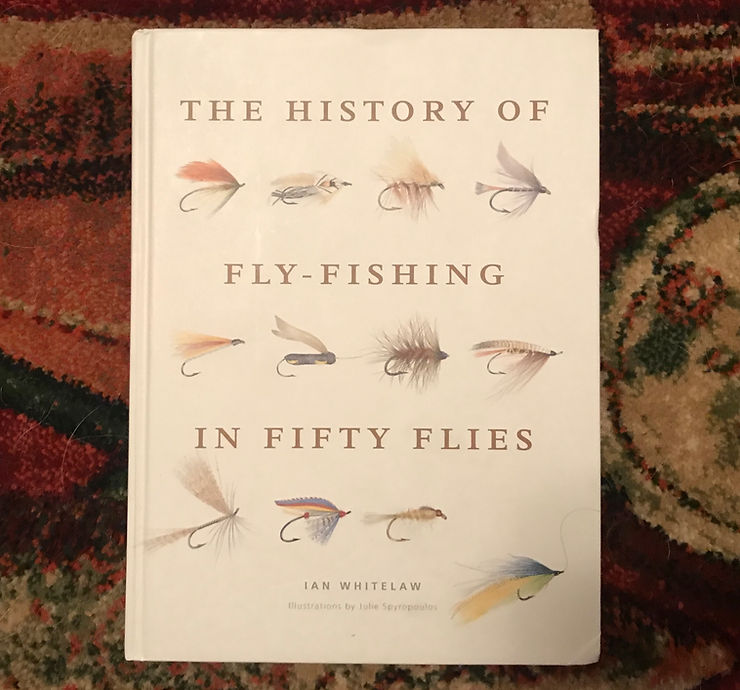The History of Fly-Fishing in Fifty Flies

I first checked out the book The History of Fly-Fishing in Fifty Flies from the local library, but I enjoyed it so much that I bought my own copy. Fly fishing is both a nostalgic and an artistic pastime. Often, the flies we use are elevated above standard trout fare. As a result, a perfectly tied Silver Doctor or Gray Ghost can be appreciated for their aesthetic beauty as much as anything, but let’s not forget the reason for their existence – to fool fish.
Over the decades, an array of fly patterns have received the label classic, and The History of Fly-Fishing in Fifty Flies by Ian Whitelaw gives you much of the background of how these patterns came to be. Here you’ll learn about the circumstances that lead innovative fly tyers to coin patterns such as the Royal Coachman, Gold-Ribbed Hare’s Ear Nymph, Matuka Streamer, and 46 others. And that’s not even counting the dozens of side stories about spin-off patterns that these flies inspired.
Some of these patterns even have roots in Pennsylvania, such as the Elk Hair Caddis. The fly was created by Al Toth, who often fished Loyalsock Creek in Lycoming County. Loyalsock Creek is a tributary of the Susquehanna River and is known for its steep gradient and rushing waters. Around 1957, Toth began developing a fly that would be more buoyant than traditional patterns. Thus, the Elk Hair Caddis was born. Inspired by a G.E.M. Skues’s pattern, the Little Red Sedge, Toth’s imitation replaced landrail feathers with elk hair and the effort produced a high floating fly that didn’t even need a front hackle.
Interestingly enough, the Elk Hair Caddis gained popularity on western rivers first, and then made its way back home here in the east. Toth moved to Dillon, MT, in 1973 and started his own fly tying business and guided fishermen. He also wrote articles for various fly fishing magazines. Since then, his creation has made the cover of Fly Fisherman magazine three times.
Theodore Gordon, who could be considered the father of modern dry fly fishing, was born in Pittsburgh, PA, in 1854. By the 1880s, brown trout stockings were beginning to take hold in much of North America, and anglers soon found out that they were much harder to catch then their rainbow and brook trout brethren. However, these newly-arrived browns, much to the delight of Gordon, who now resided in the Catskills of New York, seemed more geared toward surface feeding.
Using patterns sent to him by the fly tyer Frederick Halford as reference, Gordon developed a pattern that was better suited for New England’s freestone streams rather than England’s chalk streams. The results were flies more representative of the insects found here, and a movement that became known as the Catskill school of fly tying, punctuated by upright wings, long tails, and full hackles. As Whitelaw writes, “[Gordon’s] experiments with colors, proportions and materials eventually led him to create a fly that came to define a regional fly tying style, one that is still very much alive and kicking more than a century later.”
In this book, Pennsylvanians are credited with three other flies that have reached iconic status in the sport, the Flymph (James Leisenring 1941), the Comparadun (Al Caucci 1974), and the Clouser Minnow (Bob Clouser 1988). Although Dave Whitlock of Oklahoma gets credited for his innovative grasshopper imitation, Dave’s Hopper, the author does mention that Pennsylanian Ed Shenk was working on a similar, and more simplistic, imitation around the same time, the Letort Hopper. Both varieties have earned their places in every fly angler’s box.
When reading about the history of these famous fly patterns, you’re really reading about the history of fly fishing. Anglers have always been presented with situations that required them to be innovative and creative in order to be successful. New patterns are derived every year (if not every day!) by fishermen trying to figure out how to catch the most elusive fish in their favorite streams. And there’s no doubt that with the quality of materials available to us today that we have a great advantage over our predecessors and many of today’s patterns are extremely effective. However, that doesn’t mean we shouldn’t still pay homage to those who came before us and who laid the groundwork for our discoveries.
The Woolly Bugger, for instance, is perhaps one of the most well-known, most used flies in the world of fly fishing today. It’s almost impossible to find someone who isn’t carrying at least a couple variations of this pattern in their fly boxes. The fly was created by Russell Blessing (another Pennsylvanian) in 1967.
Although Blessing gets credit for this pattern, it borrows heavily from the Woolly Worm, which was developed and made popular almost 20 years earlier. And going back farther still, that style of tying with the palmered hackle over the body originated in England in the 1600s.
That’s the beauty of this book. It reminds us of where we come from, which, to borrow an oft-used phrase, is the only way to know where we’re going.
The History of Fly-Fishing in Fifty Flies by Ian Whitelaw is a book that you can read a dozen times and pull new and interesting information from each time. I highly recommend this one for your personal library.
Did You Enjoy Reading About The History of Fly-Fishing in Fifty Flies?
Stay up to date with the Dark Skies Fly Fishing monthly newsletter for free and receive the latest in fly fishing news, tricks, tips, and techniques, stream reports, as well as updates on new flies added to the Online Store and exclusive discounts!
Sign Up Now